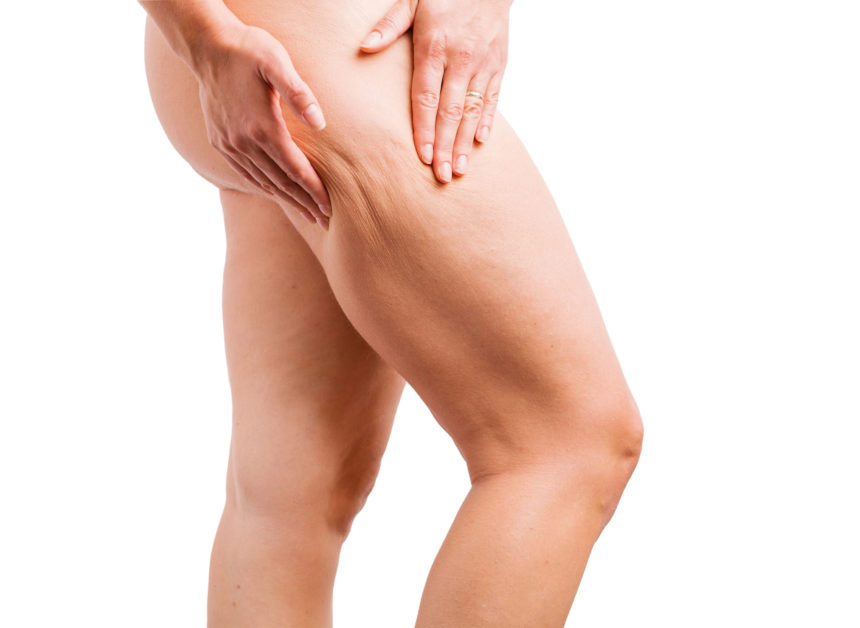Fibrous cellulite forms due to fibrosis, which is the result of hardening of the connective tissue. According to recent studies on fibrous cellulite, the combination of collagen with glucose (glycation of collagen) causes fibrosis, which means hardening of the collagen fibers and therefore of connective tissue which thus becomes a real trap for adipose cells and is difficult to treat.
Fibrous cellulite is usually located on the thighs and buttocks.
Fibrous cellulite: what causes the onset of cellulite?
Hereditary causes:
- Gender: women are more affected than men
- Genetic predisposition: heredity or familiarity
Aggravating factors:
- Vascular problems
- Hormones, oestrogens, which cause fluid retention and therefore problems with blood circulation
- Clothing that is too tight
- Stress
- Smoking and alcohol
- Overweight
- Poor diet, too many calories, too much salt and fats
- Poor posture
- Crossing the legs
- Sedentary lifestyle
- Little physical activity
- Rapid weight loss
- Standing in the same position for a long time
- High-heeled shoes
Fibrous cellulite: phases of cellulite
The individual phases in the development of cellulite are:
- Edematous phase: it generally shows up on the ankles, calves, thighs and arms. The main cause is fluid retention in the adipose tissue.
- Fibrous phase: there is an overproduction of connective-fibrous tissue, with the result that the adipose tissue becomes harder.
- Sclerotic phase: it is characterised by the presence of nodules and the adipose tissue is even more rigid.
Fibrous cellulite: types of cellulite
The different types of cellulite are:
- Compact type: this cellulite is hard to the touch and in some cases painful; it mostly affects people who are in good physical shape and have good muscle tone. It is the most common form and is the easiest to treat: it is commonly found on the knees, thighs and buttocks.
- Soft type: sclerotic nodules are present on the thighs or arms, in people who are no longer young, in people who do little exercise or in people who have significant, rapid weight changes.
- Edematous type: this cellulite is the most difficult to treat. It becomes very visible and painful.
Fibrous cellulite: what is fibrous cellulite?
Fibrous cellulite is old, stubborn cellulite which becomes difficult to get rid of and is painful to the touch.
Fibrous cellulite is, in fact, the result of the increase in connective tissue around the adipocytes, which remain trapped inside.
Fibrous cellulite is located most often on the thighs and buttocks.
The skin is hard and swollen.
Besides genetic causes, the most common causes of the formation of fibrous cellulite are related to factors such as sedentary life and poor nutrition because it mainly affects those who lead a sedentary life.
Other causes include:
- Poor blood circulation
- Water retention
- Hormonal dysfunctions
- Menopause
Fibrous cellulite can also occur with other types of cellulite, thus greatly complicating the strategy to be followed for treatment.
Tissue fibrosis begins to appear due to poor lymphatic drainage and poor cellular oxygenation. Adipocytes trapped in the tissue begin to appear with the formation of nodules that can be felt to the touch. The skin takes on a dull color and becomes flush with the classic orange-peel appearance and is cold and painful to the touch. Poor oxygenation also causes capillary fragility with the formation of capillaries that break.
Fibrous cellulite: the most suitable and personalised aesthetic medicine treatment
To understand which is the best treatment for fibrous cellulite you should consult experienced professionals, doctors and surgeons, who have adequate and proven training because a real diagnosis should be made for the treatment of cellulite, especially fibrous cellulite.
To begin with, proper nutrition and physical activity help the treatments and results that can be obtained.
The following treatments can be considered:
- Liposuction, which should always be assessed with a plastic surgeon and an expert doctor because not everyone agrees on the use of this surgical technique in the treatment of cellulite.
- Lipolaser, always after discussing it with a plastic surgeon and an expert doctor.
- tissue stabilized guided subcision, minimally-invasive with long-term results, always after discussing it with an expert doctor and plastic surgeon.
Treatment for fibrous cellulite should be chosen in a conscious manner and you should have realistic expectations. The choice of doctor is crucial because you should always seek the help of expert doctors and plastic surgeons who have been trained in the individual treatments.


